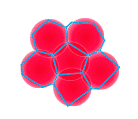Some thoughts on the underlying mechanisms of the dynamic foam:
A. It began with a medium filled with tiny oscillations [white: gas-phase]; herein ‘hotspots' appear where oscillations harmonise [red: solid-phase]; these hot-spots expand and increase the overall temperature in the gas, now bounded between these hotspots. At the sharp edges where these expanding hotspots collide, there the squeezed gas starts to flow [blue: fluid-phase].
It is comparable to the crystallisation of water into ice. Ice has a lower density, which increases the global water pressure within a closed system. When the expanding ice-volumes spread out and clash into a Voronoi-pattern, the pressurised water between the ice-blocks can no longer freeze. Think of how pressure makes ice-skating possible.
B. When freezing happens randomly throughout the medium we get a Voronoi-network of connected canals.
C. The novelty to this model is that these fluid-edges can form a circuit of currents and rules, similar to those of Game of Life, emerge. Currents can block each other and cells die; or currents can merge and cells grow. Heat is transported through the network making some volumes expand while others shrink -> the foam becomes dynamic:
D. Finally rolling waves emerge. For instance we can focus on the one red cell bottom right, that fluctuates in size but keeps its position, while it looks as if the ensemble of cells rotates. What is rotating is the change in size, not the bubbles themselves. What is being transported around, is the heat within the edges.
The mechanics are similar to normal waves, drive, by external forces; but in dynamic foam model the drive comes from the energy that runs internally through the circuit/edges between the bubbles, heating up some bubbles and making them expand while others cool down and shrink.







